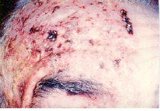Herpes zoster, commonly known as shingles, is a painful blistering rash caused by the same virus that causes chickenpox. Find out what causes herpes zoster and how to identify and treat it.
If you have had chickenpox, the varicella-zoster virus that caused it may continue to live on in an inactive state in the nerves linked to your spinal cord, even after the spots have cleared.
This inactive virus causes herpes zoster, and a temporary weakening in the body’s resistance may trigger the virus to become active again. It then multiplies and moves along the nerve fibres to the skin supplied by the affected nerves. Herpes zoster symptoms of painful rashes and blisters then appear on the skin.
Most attacks of shingles occur for no obvious reason, but an attack is more likely if:
- You are elderly
- You are under stress
- You have an illness that weakens the immune system such as cancer (e.g leukaemia, a lymphoma) or AIDS
- You have been given treatments that suppress the immune system, including irradiation for cancer, chemotherapy and drugs taken to prevent organ rejection
Related: AIDS — What Women Should Know
Herpes Zoster Symptoms
The first symptom is often a burning pain or tingling sensation, or extreme sensitivity in one area of the skin. This may be present itself one to three days before a red rash occurs. Groups of blisters on a red base usually follow. The blisters, which usually only show on one side of the body, may last for two to three weeks. During this time, pus may appear and then crust over. Herpes zoster symptoms will begin to disappear on their own, though some pain may persist.
How Severe Is the Pain?
The pain can be severe enough for you to request for painkillers. Post-herpetic neuralgia, a persistent painful complication of shingles can occur, especially in older individuals. Ingestion of antiviral drugs during a bout of shingles may reduce the risk of getting post-herpetic neuralgia in individuals above 50 years of age.
Related: Medication, Dispensing & Counselling
Where Do Shingles Appear on the Body?
Most commonly, blisters will appear on one side of body, the buttocks and genitalia, or the face in the distribution of the nerve(s) supplying the area. If the blisters involve the eye region, permanent eye damage can result and your doctor will refer you immediately to an eye specialist.
Related: Look Into It
Herpes Zoster Complications
Post-herpetic neuralgia: a condition in which constant or episodic pain persists for a long time after the skin has healed.
Bacterial infection of the blisters: this can lead to delayed healing of the skin. Antibiotics are needed in these instances.
Rarely, high fever may result and the disease may spread all over the body in very serious cases.
How Do I Know If I Have Shingles?
This is by the appearance of the blisters and pain on one side of the body. To be certain, your doctor may do a special test called a Tzanck smear in which scrapings from the blister are put on a slide and examined under the microscope for “giant cells”.
Is Shingles Contagious?
Shingles is much less contagious than chickenpox. People with shingles can spread the virus if blisters are broken and a susceptible person (someone who has never had chickenpox or who is already ill) is close by. The main people at risk are babies or those who are already ill, e.g from cancers or AIDS.
Related: AIDS and HIV
How Much Scarring Is There?
Scarring occurs in those who have more severe infections; elderly people, those whose blisters have become infected, who use toxic home remedies, who treated their rashes by burning or scalding them, or those who have used chemicals as a herpes zoster treatment.
Herpes Zoster Treatment
Shingles usually resolves spontaneously in a few weeks and seldom recurs. Herpes zoster treatment consists of painkillers, as well as cool compresses to help in drying the blisters. Antiviral medications like acyclovir are usually given for severe cases of shingles, particularly for those with eye involvement or who are seriously ill.
If taken within the first few days of the attack, acyclovir can shorten the duration of the attack. Post-herpetic neuralgia can be treated with topical painkillers such as lignocaine gel or capsaicin or simple analgesics such as paracetamol. In severe, persistent post-herpetic neuralgia, tricyclic antidepressants can be used to relieve the pain. See your doctor early for more effective herpes zoster treatment.
Related:
Do You Really Need Antibiotics?

Figure 1: Herpes Zoster (Shingles) - red patches and blisters appear in a band on one side of the body.

Figure 22: If herpes zoster affects the region around the eye, the eye itself may also be affected
Read these next:
















